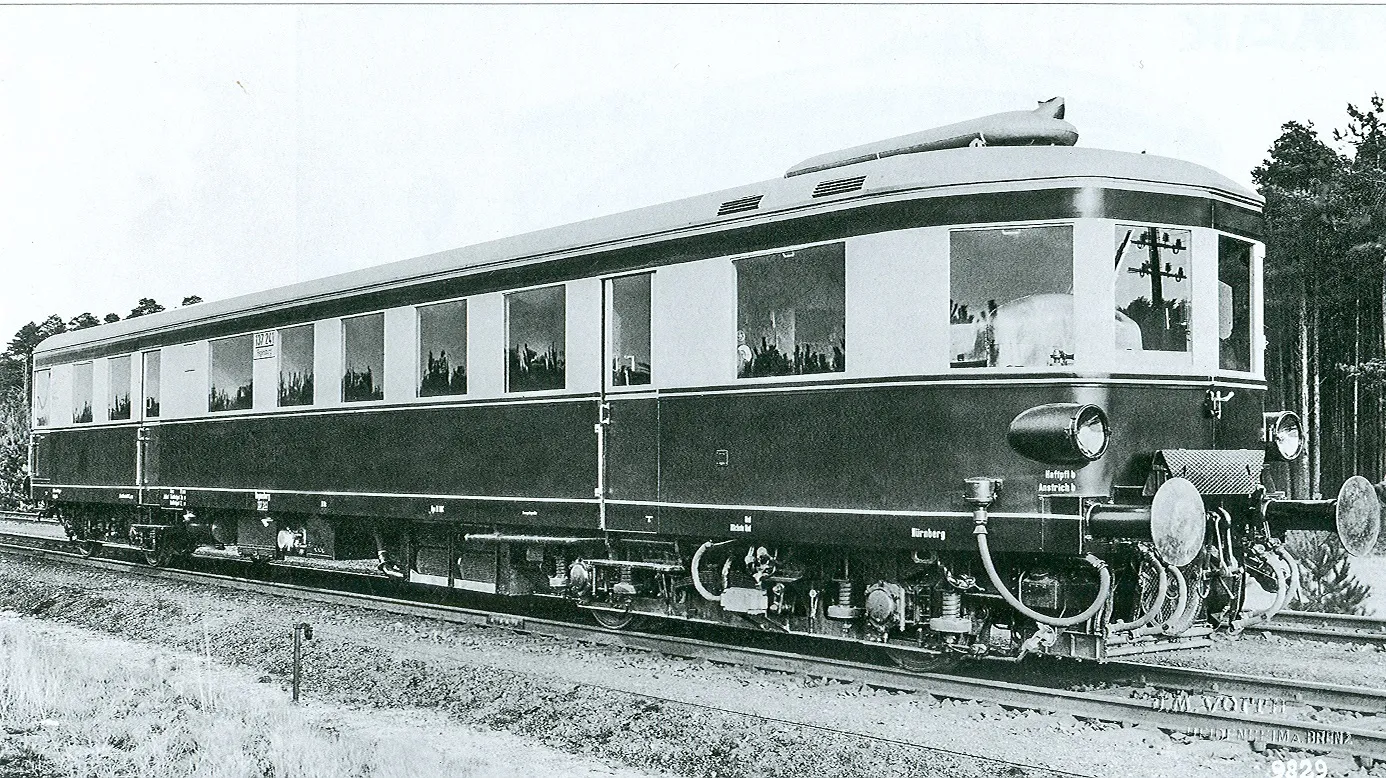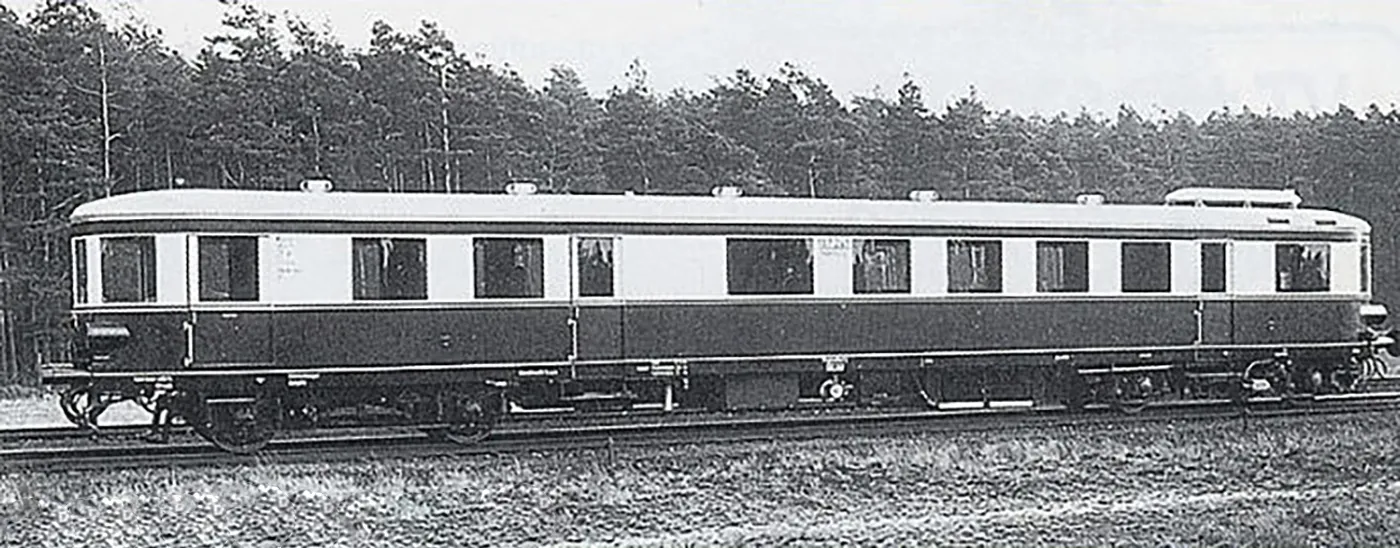
Source: commons.wikimedia.org
VT 137 241 - 270 & 442 - 461
Vehicle type:
Registration country:
Railway companies:
1937
The first experiments with hydraulic transmissions were conducted
with the two-axle diesel railcar VT 803. After two
additional experimental vehicles with hydraulic power transmission,
three two-axle diesel-hydraulic railcars (VT 135 048 -
050) were delivered in 1935. The success of Voith
transmissions led the DRG to expand their use to vehicles with
higher power classes. Within the 200 kW and 300 kW railcar classes,
typically featuring diesel-electric drives, several experimental
vehicles (VT 137 162, VT 137 163,
and VT 137 160, VT 137 161,
VT 137 271, VT 137 272) were
equipped with hydraulic transmissions.
Before these experimental railcars were delivered, the DRG ordered 50 diesel-hydraulic railcars in two series in 1937/38 and 1940/41 for branch line operations. These units were classified as VT 137 241 - 270 and VT 137 442 - 461. They were designed for double-heading and control car operation. For the first series, control cars VS 145 154 - 183 were procured in 1936/37, and for the second series, VS 145 347 - 366 in 1940.
Manufacturing and Design
Railcars VT 137 241 - 254 of the first series were produced by the Dessau Wagon Factory (design F52/801g), while VT 137 255–270 were manufactured by Uerdingen Wagon Factory (design F52/801f). The second series (VT 137 442 - 461) was exclusively built by the Dessau Wagon Factory (design F52/908f). MAN and Voith supplied the power units.
Car Body and Frame
The car bodies differed significantly from earlier “standard design” railcars. To accommodate low platforms on branch lines, the floor and overall car height were reduced. Rounded ends were replaced with angular designs composed of multiple slanted surfaces.
The chassis was a lightweight, welded construction made from steel sheets, angles, and rolled profiles. The main side profiles narrowed at the entry areas, forming the middle step of the entry staircase. Floors, made from 15 mm plywood with linoleum covering, were generally 1070 mm above the rail level, raised to 1175 mm over the machinery bogie.
Passenger compartments featured crank-operated windows (1000 mm wide for 3rd class, 1200 mm for 2nd class) and fixed safety glass windscreens. Ventilation was provided by five Flettner exhaust fans on the roof. The passenger layout included a 3rd class open space with 2+3 seating and a 2nd class compartment with 2+2 seating (3+0 in the second series). The vehicles also included a baggage area with folding seats and a toilet.
Bogies and Propulsion
The powered bogie had a 3600 mm wheelbase and housed the drivetrain. It was equipped with a three-stage suspension (four-stage in the second series). The unpowered bogie had a 3000 mm wheelbase. Both featured lightweight, roller-bearing wheelsets with a 900 mm diameter. A pneumatic block brake system operated on all axles, and a handbrake acted only on the respective bogie.
The powertrain included a slow-running MAN W6V22/30 diesel engine delivering 360–400 PS at 870–900 rpm. The power was transmitted via a Voith double-turbine transmission JJ 14 Cg 8.8 (later T 45 KZ), providing seamless shifting at 48 km/h and 71 km/h. A pneumatic system controlled direction changes, possible only when stationary.
Cooling and Heating
The cooling system used a four-block radiator, ventilated by fans driven by the Voith transmission. For winter operations, the radiators could be partially or fully covered. Heating systems varied between series: the first series used an oil-fired air heating system, while the second series employed a combination of air and water heating systems.
Electrical Equipment
The railcar’s 110V DC system was powered by a BBC generator GS 10c (8 kW) or by batteries when stationary. Electrical components included lighting for passenger compartments, speedometers, thermometers, oil pressure indicators, and a fire detection system. The vehicles were also equipped for remote control operation.
Deployment and Modifications
The first series (VT 137 241–270) was assigned to depots in Mainz, Regensburg, Dresden, and Chemnitz in 1937/38. With the outbreak of World War II, many were repurposed for military use, leading to the loss of 17 units. After the war, some vehicles served the DB and DR, while others were sold to private railways.
The second series (VT 137 442–461) was initially intended for Regensburg and Nuremberg but was quickly repurposed for military use. Post-war, several units found their way to the DB and DR, with modifications and continued use into the 1960s.
Key modifications included:
• Reinforced crossbeams in the powered bogie.
• Improved engine mounts and cooling systems.
• Increased maximum speed to 100 km/h (aligned with the second series).
Before these experimental railcars were delivered, the DRG ordered 50 diesel-hydraulic railcars in two series in 1937/38 and 1940/41 for branch line operations. These units were classified as VT 137 241 - 270 and VT 137 442 - 461. They were designed for double-heading and control car operation. For the first series, control cars VS 145 154 - 183 were procured in 1936/37, and for the second series, VS 145 347 - 366 in 1940.
Manufacturing and Design
Railcars VT 137 241 - 254 of the first series were produced by the Dessau Wagon Factory (design F52/801g), while VT 137 255–270 were manufactured by Uerdingen Wagon Factory (design F52/801f). The second series (VT 137 442 - 461) was exclusively built by the Dessau Wagon Factory (design F52/908f). MAN and Voith supplied the power units.
Car Body and Frame
The car bodies differed significantly from earlier “standard design” railcars. To accommodate low platforms on branch lines, the floor and overall car height were reduced. Rounded ends were replaced with angular designs composed of multiple slanted surfaces.
The chassis was a lightweight, welded construction made from steel sheets, angles, and rolled profiles. The main side profiles narrowed at the entry areas, forming the middle step of the entry staircase. Floors, made from 15 mm plywood with linoleum covering, were generally 1070 mm above the rail level, raised to 1175 mm over the machinery bogie.
Passenger compartments featured crank-operated windows (1000 mm wide for 3rd class, 1200 mm for 2nd class) and fixed safety glass windscreens. Ventilation was provided by five Flettner exhaust fans on the roof. The passenger layout included a 3rd class open space with 2+3 seating and a 2nd class compartment with 2+2 seating (3+0 in the second series). The vehicles also included a baggage area with folding seats and a toilet.
Bogies and Propulsion
The powered bogie had a 3600 mm wheelbase and housed the drivetrain. It was equipped with a three-stage suspension (four-stage in the second series). The unpowered bogie had a 3000 mm wheelbase. Both featured lightweight, roller-bearing wheelsets with a 900 mm diameter. A pneumatic block brake system operated on all axles, and a handbrake acted only on the respective bogie.
The powertrain included a slow-running MAN W6V22/30 diesel engine delivering 360–400 PS at 870–900 rpm. The power was transmitted via a Voith double-turbine transmission JJ 14 Cg 8.8 (later T 45 KZ), providing seamless shifting at 48 km/h and 71 km/h. A pneumatic system controlled direction changes, possible only when stationary.
Cooling and Heating
The cooling system used a four-block radiator, ventilated by fans driven by the Voith transmission. For winter operations, the radiators could be partially or fully covered. Heating systems varied between series: the first series used an oil-fired air heating system, while the second series employed a combination of air and water heating systems.
Electrical Equipment
The railcar’s 110V DC system was powered by a BBC generator GS 10c (8 kW) or by batteries when stationary. Electrical components included lighting for passenger compartments, speedometers, thermometers, oil pressure indicators, and a fire detection system. The vehicles were also equipped for remote control operation.
Deployment and Modifications
The first series (VT 137 241–270) was assigned to depots in Mainz, Regensburg, Dresden, and Chemnitz in 1937/38. With the outbreak of World War II, many were repurposed for military use, leading to the loss of 17 units. After the war, some vehicles served the DB and DR, while others were sold to private railways.
The second series (VT 137 442–461) was initially intended for Regensburg and Nuremberg but was quickly repurposed for military use. Post-war, several units found their way to the DB and DR, with modifications and continued use into the 1960s.
Key modifications included:
• Reinforced crossbeams in the powered bogie.
• Improved engine mounts and cooling systems.
• Increased maximum speed to 100 km/h (aligned with the second series).
1949
After the war, these units are spread as following:
- 16x railcars are taken over by the Deutsche Bundesbahn where they are registered as VT 36;
- 5x railcars are taken over by the Deutsche Reichsbahn;
- 1x unit (VT 137 471) will be registered as Series 765 with the Romanian Railways (CFR).
- 16x railcars are taken over by the Deutsche Bundesbahn where they are registered as VT 36;
- 5x railcars are taken over by the Deutsche Reichsbahn;
- 1x unit (VT 137 471) will be registered as Series 765 with the Romanian Railways (CFR).
Sources: https://www.triebwagenarchiv.de/index.php?nav=1000436&lang=de, https://de.wikipedia.org/wiki/DR_137_241_bis_270, https://www.drehscheibe-online.de/foren/read.php?030,6503423,6504152#msg-6504152
Do you have additional informations regarding this vehicle?
Help us writing the history of VT 137 241 - 270 & 442 - 461! Your knowledge is precious for us and the entire community, do not hesitate to share your facts, photos or videos:
Latest update on the 8th of December 2024 at 17:13
Contributor(s): Tudor C.
Discussion forum





